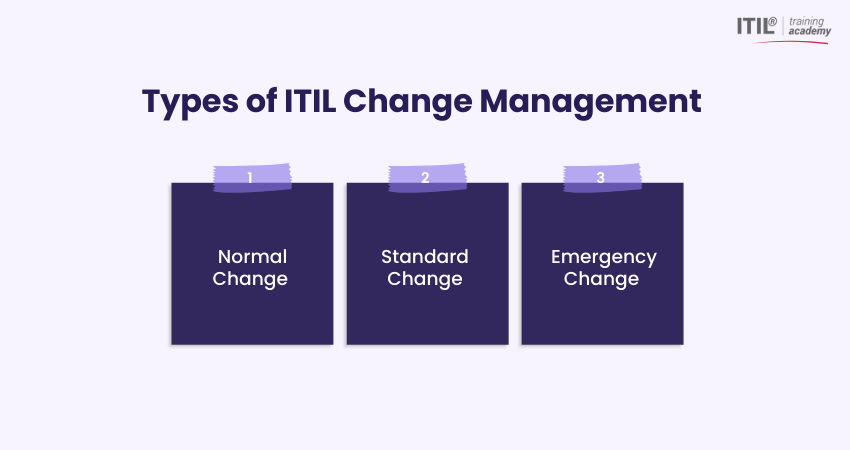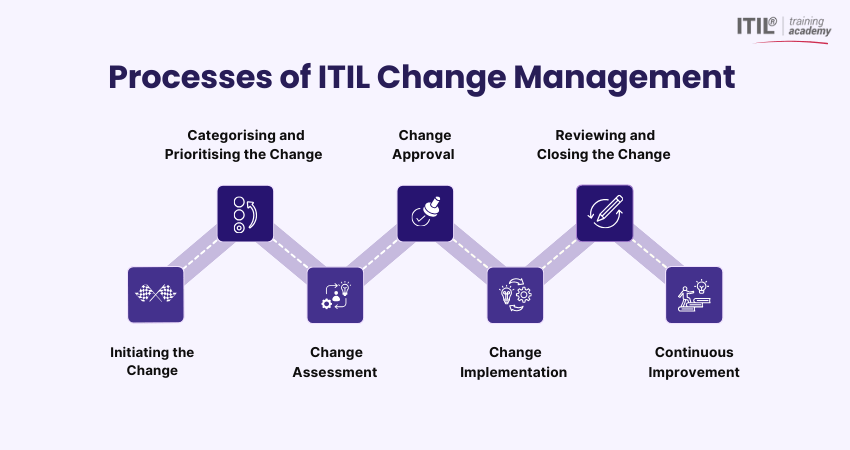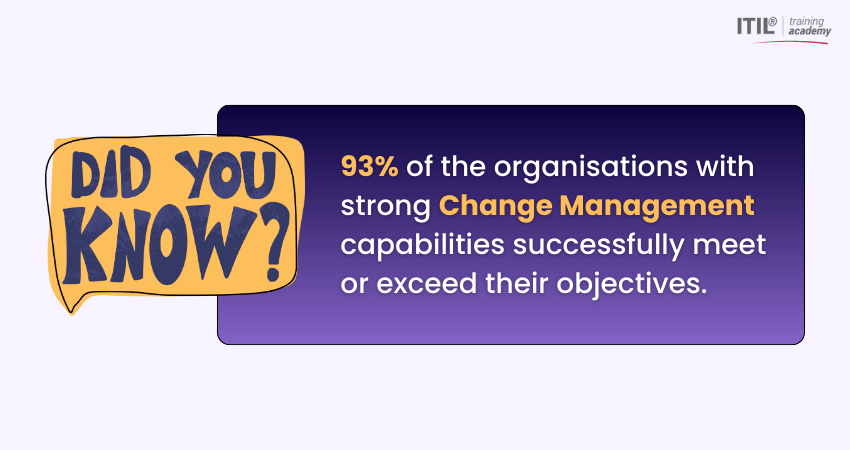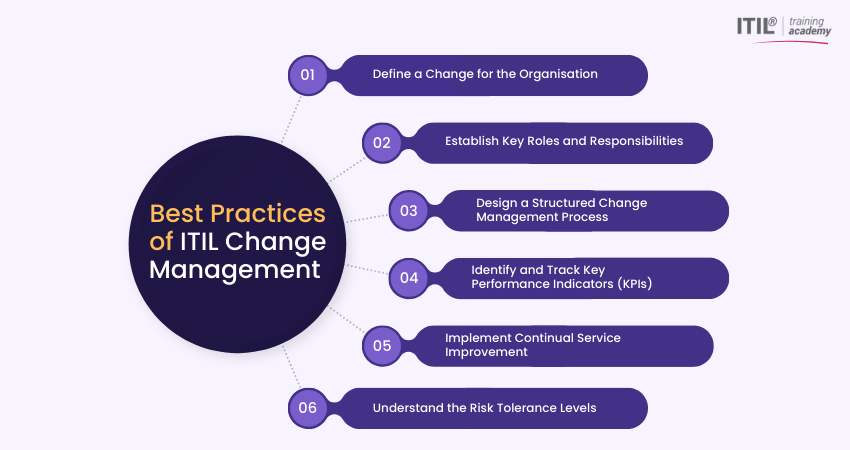
Author-Veronica Davis
Last updated-Aug 22, 2025
Every change is an opportunity! Yes, you heard it right. As the world welcomes new evolution in technology, changes become an inevitable reality. Instead of fearing those disruptions, you can embrace the changes as a chance to grow, a fuel to innovation, and a way to deliver value to customers.
This is exactly what ITIL Change Management is designed for. It turns IT changes into smooth, well-planned steps rather than risky leaps. Do you want to overcome uncertainty, improve teamwork, and keep services stable? Then, read on this blog to explore how ITIL ensures change becomes a driver of progress!
Table of Contents
1) What is ITIL Change Management?
2) Importance of ITIL in Change Management
3) Types of ITIL Change Management
4) ITIL Change Management Processes
5) Benefits of ITIL Change Management
6) Common Challenges in ITIL Change Management
7) Best Practices for Implementing ITIL Change Management
8) Conclusion
What is ITIL Change Management?
ITIL Change Management is a key process within the IT Service Management (ITSM) framework under the Information Technology Infrastructure Library (ITIL). It is a structured way to handle changes in IT services and systems safely, efficiently, and with minimal disruption.
It ensures that every change is carefully planned, approved, tested, and reviewed before and after implementation. By following it, you can reduce downtime, improve service quality, enhance collaboration across teams, and align IT changes with business goals. Ultimately, it transforms change from a potential threat into an opportunity for growth and innovation.
Importance of ITIL in Change Management
Change is inevitable in IT services, and it can’t be neglected. So, let’s check the importance of having ITIL in your Change Management process:
1) Standardisation and Consistency: ITIL follows a clear, repeatable process for managing changes, reducing errors, and ensuring reliability across the organisation.
2) Risk Management: Every change is assessed for potential risks before approval. By following a formal process, the chance of failures and downtime is reduced.
3) Improved Service Quality: ITIL focuses on continuous improvement, ensuring changes deliver measurable benefits and enhance overall service performance.
4) Agility and Responsiveness: By offering flexible guidelines, ITIL allows IT teams to adapt quickly to evolving business needs while maintaining stability.
5) Clear Roles and Responsibilities: Defined roles help teams know exactly who is responsible for approvals, assessments, and implementations. This improves accountability.
6) Documentation and Audit Trails: Detailed records of every change support compliance, audits, and ongoing process improvement.
7) Better Stakeholder Communication: ITIL ensures all stakeholders are kept informed throughout the change lifecycle. This reduces resistance and builds trust.
Types of ITIL Change Management
Not all changes are the same. Some are small, some are big, and some are urgent. Therefore, ITIL divides them into three main types. Let's check what those types are:

1) Normal Change
A normal change is neither standard nor emergency but requires full evaluation.
1) Performs assessment, approval, testing, and review
2) Involves non-trivial changes to IT services, processes, or infrastructure
3) Reviewed and authorised by the Change Advisory Board (CAB)
Example: Upgrading a server or introducing a new business application
2) Standard Change
A standard change is low risk, frequent, and pre-approved.
1) Follows a pre-defined, established procedure
2) Considered routine tasks, tracked as service requests instead of change requests
3) It does not require a detailed assessment each time
Example: Installing regular patches, creating user accounts
3) Emergency Change
An emergency change is urgent and must be implemented quickly.
1) Usually triggered by critical incidents or security issues
2) Follows a fast-tracked approval process but still requires documentation
3) Usually approved by an Emergency Change Advisory Board (ECAB)
Example: Fixing a critical security vulnerability or restoring a failed core system
Ensure consistent change execution with our ITIL® 4 Specialist: Plan, Implement and Control Training – Register today!
ITIL Change Management Processes
The ITIL framework follows a structured process for handling changes. Let’s check what those Change Management processes are:

1) Initiating the Change
A change begins with a Request for Change (RFC), raised for reasons such as business needs, process improvements, legal requirements, or fixing issues. Then the request is documented in detail, explaining the purpose, scope, and expected impact.
2) Categorising and Prioritising the Change
The request is now classified into one of the types of ITIL Change Management to decide the right process. Here, the priority of the change is set based on urgency and potential impact on business operations.
3) Change Assessment
A Change Advisory Board (CAB) or designated reviewers evaluate the risks, costs, benefits, and impacts. This step ensures that no important risk or dependency is overlooked.
4) Change Approval
Approval for the changes is granted at the right organisational level, depending on the risk and impact. Major changes may need Senior Executive approval, while emergency changes follow a fast-track approval process.
5) Change Implementation
Once the approval is received from the concerned people, the change is planned, scheduled, and executed. Responsibilities, timelines, and rollback (backup) plans are defined to ensure a smooth transition.
6) Reviewing and Closing the Change
Once the change is successfully implemented, it is reviewed to confirm whether it has achieved its objectives. It helps to analyse the unexpected issues, and lessons learned are documented for future improvements.
7) Continuous Improvement
ITIL Change Management doesn’t stop with implementing the change effectively, but also checking the progress frequently. It promotes continual service improvement by using insights from past changes. With this, the processes are refined over time, making Change Management more efficient and effective.
Support business objectives without disrupting ongoing operations with our ITIL® 4 Practitioner: Service Configuration Management Training – Join now!
Benefits of ITIL Change Management
Here are the benefits that come with implementing ITIL Change Management for your IT services:
1) Increased Efficiency
1) Provides clear, repeatable steps for all changes
2) Reduces time wasted on unplanned activities
3) Minimises duplication of work across teams
4) Improves resource allocation and utilisation
5) Ensures faster completion of change requests
6) Helps IT teams focus on delivering value instead of firefighting
2) Risk Reduction
1) Every change is assessed for possible risks
2) Approval steps prevent poorly planned changes
3) Testing reduces the chance of unexpected failures
4) Backup and rollback plans allow quick recovery
5) Identifies dependencies before implementation
6) Reduces service downtime and outages
3) Improved Service Quality
1) Prevents service disruptions during changes
2) Keeps systems stable and reliable for users
3) Increases customer satisfaction with smoother services
4) Ensures changes deliver measurable benefits
5) Focuses on long-term service improvement
6) Aligns IT performance with business goals
4) Better Communication Across Teams
1) Keeps all stakeholders informed at each stage
2) Reduces confusion about responsibilities and timelines
3) Encourages collaboration between IT and business teams
4) Improves transparency in decision-making
5) Ensures users understand the reason for changes
6) Reduces resistance to change through clear messaging
5) Continuous Improvement
1) Encourages regular reviews after every change
2) Captures lessons learned to improve future processes
3) Identifies patterns in failed or successful changes
4) Enhances workflows for faster and smoother approvals
5) Promotes a culture of learning within IT teams
6) Ensures the change process evolves with business needs
Common Challenges in ITIL Change Management
Though ITIL Change Management has high benefits, it has its own limitations, too. Here are its challenges:
1) Resistance to Change
Employees may feel hesitant to adopt new processes or technologies, fearing disruption to their routine. Strong communication, proper training, and involving employees early can help overcome this challenge.
2) Resource Constraints
Limited budgets, staffing shortages, or lack of time can delay projects or weaken change outcomes. Careful resource planning and prioritisation are essential to handle these challenges.

3) Complex IT Environments
Modern IT systems are deeply interconnected, so one small change can trigger unexpected issues somewhere else. In order to avoid this, you need to do thorough testing and impact assessments before implementation.
4) Lack of Documentation
Without proper records, it will become really difficult to track changes, audit decisions, or learn from mistakes. To avoid this, you can do consistent documentation to maintain transparency and accountability.
5) Ensuring Regulatory Compliance
Industries like healthcare, finance, and government have strict compliance rules. Therefore, every change needs to align with the legal and industry standards of your business to avoid any penalties or risks.
Provide excellent service delivery across IT support environments with our ITIL® 4 Specialist: Monitor, Support, and Fulfil Training – Sign up soon!
Best Practices for Implementing ITIL Change Management
In today’s business world, organisations are subjected to constant changes. To handle them effectively, you can follow Change Management practices. The following are the best practices that can help you adopt and implement ITIL Change Management successfully:

1) Define a Change for the Organisation
The first step is to clearly define what counts as a change. Some organisations may treat small routine updates as service requests, while others classify them as changes. Without a clear definition, confusion arises, and important updates may bypass proper approval. Having an agreed definition ensures consistency across all teams.
Tip: Create a simple checklist or flowchart that employees can use to decide whether an update qualifies as a “change.”
2) Establish Key Roles and Responsibilities
ITIL works best when everyone knows their role in their project or work. Roles such as the Change Manager, Change Advisory Board members, and technical leads should be clearly defined. This avoids duplication of effort, ensures accountability, and prevents delays. Clear responsibilities also encourage better communication between IT and business stakeholders.
Tip: Document each role with its responsibilities and decision-making authority in a RACI matrix.
3) Design a Structured Change Management Process
Not all changes are equal. ITIL recommends structured workflows for normal, standard, major, and emergency changes. Each type has its own level of risk assessment, approval, and documentation. A well-defined process ensures that small routine tasks don’t get stuck in unnecessary bureaucracy, while large, risky changes receive the attention they need.
Tip: Build workflow templates for normal, standard, major, and emergency changes so teams can follow consistent, pre-approved steps.
4) Identify and Track Key Performance Indicators (KPIs)
To measure success, you need to track your performance. Useful KPIs include the number of successful changes, failed changes, emergency changes, and the average time taken for approvals. Monitoring KPIs helps identify bottlenecks and highlight areas where the process can be improved.
Tip: Focus on a few meaningful KPIs such as percentage of successful changes and average approval time, and review them monthly.
5) Implement Continual Service Improvement
Change Management is not a static one. Instead, it is a dynamic practice. Regular reviews of past changes will help you identify the lessons that you have learnt previously and improve future performance. This cycle of continual service improvement ensures that the process evolves alongside business needs and technological advances.
Tip: Hold quarterly “lessons learned” sessions to evaluate past changes, highlight gaps, and suggest improvements.
6) Understand the Risk Tolerance Levels
Every organisation has a different level of risk that it can accept. Some industries, like finance or healthcare, require strict compliance and minimal tolerance for risk, while others may allow more flexibility. By setting clear risk tolerance levels, you can balance innovation with stability and avoid over-caution and reckless decision-making.
Tip: Define a risk scoring system like low, medium, and high and use it consistently during assessments to speed up decision-making.
Conclusion
ITIL Change Management is more than just a set of rules. It is a safeguard that allows you to innovate while protecting stability. By classifying changes, following structured processes, and applying best practices, as a business, you can reduce risks, improve efficiency, and maintain service quality. With this, every change becomes a step forward in growth and innovation.
Elevate your Service Management expertise with our ITIL® 4 Practice Manager (PM) Courses – Explore immediately!
Most Recent
Date - Sep 20, 2025
Date - Sep 20, 2025
Date - Sep 20, 2025





 Back to
Topics
Back to
Topics

























